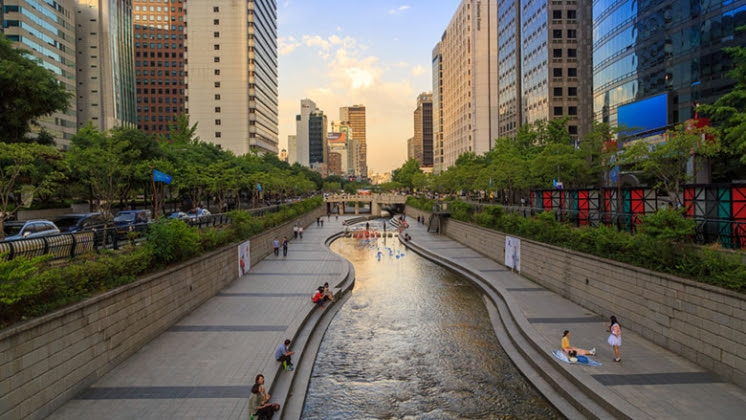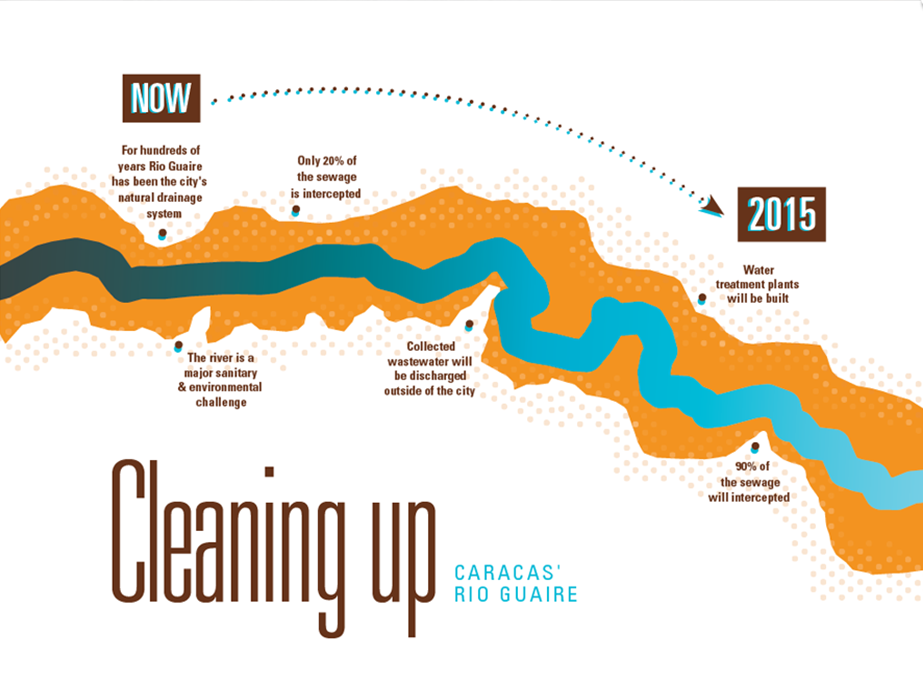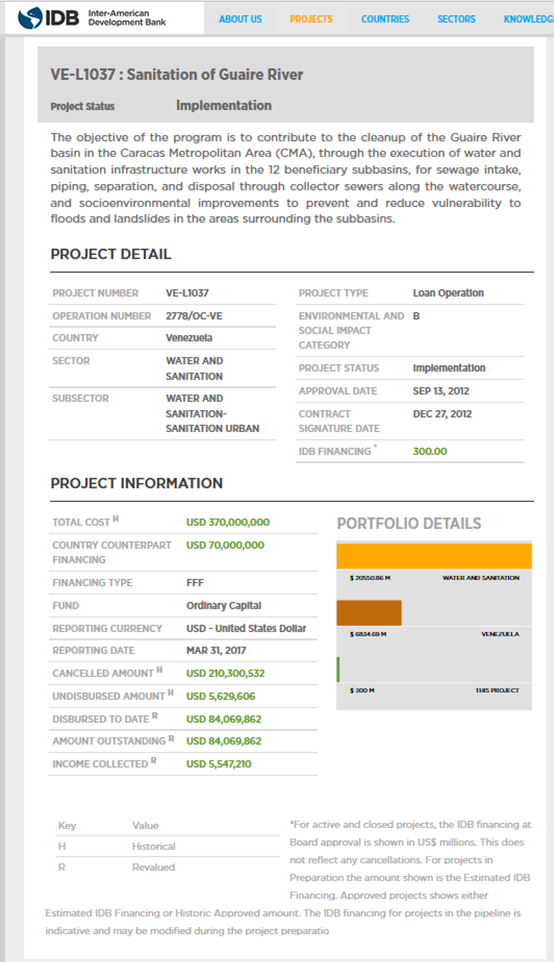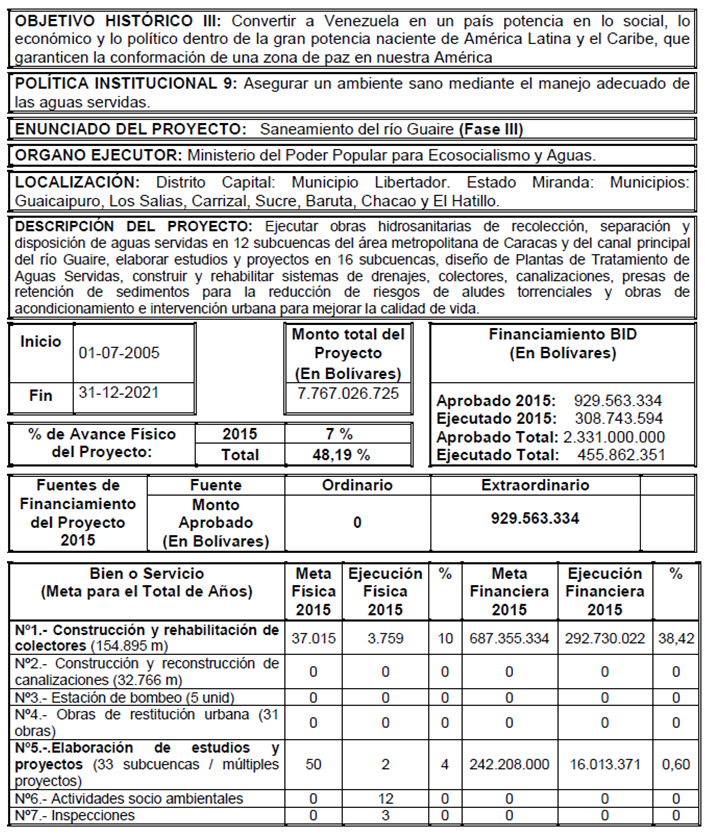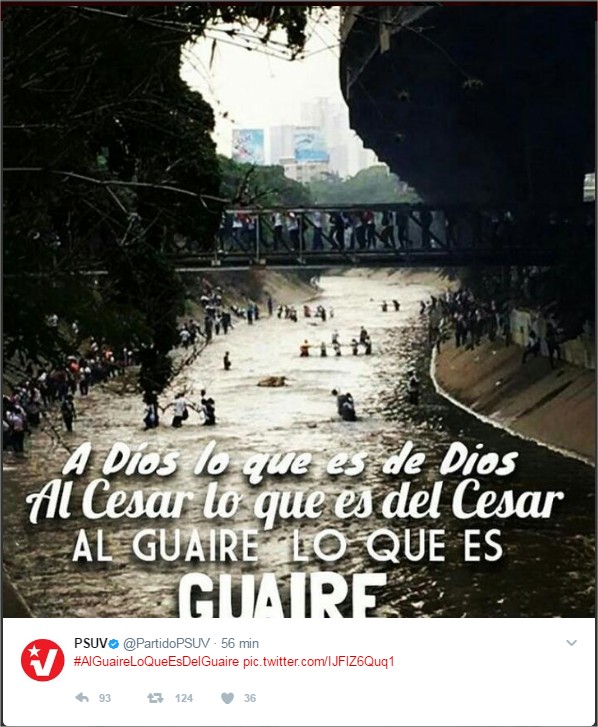Seeking Refuge in a River of Broken Promises
Yesterday, under the onslaught of tear gas, desperate opposition protesters jumped into the toxic Rio Guaire. Twelve years after Hugo Chávez promised to clean up the river, hundreds of millions have been spent for no results at all.


Few images were as shocking to caraqueños yesterday as the sight of protesters wading into the Rio Guaire to escape the tear gas on the East Side Highway. Caraqueños know the Guaire is basically an open sewer, the place where the city’s waste, both human and industrial, all ends up.
It’s an old problem. As far back as 1946, Carmen Clemente Travieso was writing:
Rio Guaire, the same that flowed through meadows and sugar cane fields, that formed wells of warm water for inhabitants of Caracas and sorrounding areas to bath, that was inspiration to poets and writers who visited old days Caracas, is now only an infectious and dark sewer that says nothing about the power and beauty it used to have.
According to Inter-American Development Bank, “as the population of the metropolitan area increased over the centuries to its current 4.2 million inhabitants, the Guaire has been the main repository for disposing of untreated wastewater and toxic substances. Today the river not only smells bad, it also represents a major sanitary and environmental challenge for Caracas because only 12 percent of the city’s wastewater is currently treated.”
What made yesterday’s images especially shocking is that chavismo had promised to do something about it.
Back in August, 2005, President Chávez was telling foreign heads of state to come for a dip. “Daniel Ortega, I invite you to take a swim in El Guaire next year…con un sancocho…en verdad, es en serio, estamos recuperando el río Guaire.”
Since 2005, chavistas have been telling us in a few years, the Guaire will look like this:
Of course, that’s not the Guaire at all: that’s the Cheonggyecheon River in Seoul, South Korea. The river was turned into a city green-space replacing a highway that had covered it up years back. The clean-up project began in 2000 and the finished project was opened to the public in 2005, after $280 million in investments, generating tons of environmental, social and economic benefits. The 5.8 km. long Cheonggyecheon is a lot shorter than the Guaire, granted, but the parts that pass through heavily urbanized areas are relatively similar in length.
So that’s what $280 million buys you in South Korea. How much has gone into the Project to Clean-Up the Rio Guaire?
The project was officially launched on July 1st 2005 and was meant to consist of cleaning the waters of the main river and all the city streams that flow into it. The project —originally— had two phases: the first started in August 2005 and was meant to end in early 2007, and went from the community of San Pedro to the Anauco stream. The second phase, scheduled from 2007 to 2014, would go cover everything from the Anauco stream to Petare-El Llanito.
The sociologist Juan Bautista González participated in the social component of the first phase. He says, a mind-bending $14 billion was approved in 2005 to finance the project, but the “money disappeared and the work was not completed.”
Caraqueños eventually began to question the progress of the project. Eventually, a couple of revolucionarios came to the rescue.
Rio Guaire, the same that flowed through meadows and sugar cane fields, that formed wells of warm water for inhabitants of Caracas and sorrounding areas to bath, that was inspiration to poets and writers who visited old days Caracas, is now only an infectious and dark sewer that says nothing about the power and beauty it used to have.
FYI, in 1957 the British Natural History Museum declared the Thames biologically dead. Today it is home to seals, porpoises and even the occasional stray whale. Paris wants to make the Seine swimmable by 2024. These are long-term projects and, once the waters are clean, they will require constant surveillance and guardianship.Faria was so sure the project would be concluded successfully that she tweeted “I’m going to jump in, but in 2014 when the clean-up process of the Rio Guaire culminates.” She said the clean-up process would end up being faster than that of the River Thames or the Seine.Jacqueline Faria, who was the Minister for Environment when the project was launched in 2005, answer critics of the project in a couple of Tweets. That’s how we learned that, as of June 2010, the project’s progress was at a suspiciously precise 24.7% and the investment added up to “554 million” —not sure if she meant US dollars or bolivars. If it was bolivars she was referring to, 554 million is close to $129 million at the official FX rate at the time: 4.3 BsF/US$.
This was when the Inter-American Development Bank (IDB) came in.Two years after Faría’s confident forecast, in May 2012, the next Minister for Environment Alejandro Hitcher reaffirmed that the project would be ready by 2014 and added: “the works on the Rio Guaire are on their way, the issue is that they cannot be seen because they consist of a sewer system that’s being built below the city.”
The bank says that, since 2012, “with support from the IDB, Caracas is working to clean up the Guaire by investing in sanitation infrastructure”. As you can see in the map below, taken from IDB’s web page, by 2015 water treatment plants were supposed to be built and 90% of the sewage was supposed to be intercepted.
The contract for IDB’s project VE-L1037: “Sanitation of Guaire River” was signed in December 2012 and is still being “implemented.” IDB is meant to finance $300 million and Venezuela’s government another $70 million. According to Part I of the Loan Contract No. 2778/OC-VE, the disbursement period was originally 4 years and the amortization period is 25 years, running from the date the loan contract was signed (October 27th, 2012).
The latest public version of the “Project Monitoring Report” published on December 23rd 2016, the IDB had disbursed US$ 83,699,468.10 (27.9%) by June 2016. If we take a look at the project’s summary chart (you can see it right below), the IDB had disbursed US$ 84,069,862 by March 2017.
As you can imagine, the Guaire was nowhere ready for our enjoyment in 2014. But of course it wasn’t the revolution’s fault; it was evil capitalists’.
“Who contaminated the Guaire and all the springs of this beautiful Caracas, cradle of Bolivar?” the president asks. “Who? Capitalism with its destructive vision.”
According to the Memoria y Cuenta 2015 -the latest available to the public- of the Ministry for the Environment (now called Ministry for the Ecosocialism and Waters), the “Sanitation of the Rio Guaire” project is now on phase 3 and should be done by December 2021. According to this document, the total cost of the project is BsF 7.767 billion and close to BsF.456 million (5.9%) had been executed so far.
Although the project is nowhere near finished, PSUV tweeted —and then deleted— an image of the protesters wading into the Rio Guaire to escape the tear gas accompanied with a pretty sickening statement: “A Dios lo que es de Dios, al César lo que es del César, al Guaire lo que es del Guaire”.
President Maduro even retweeted the image.
Just to be clear: the contamination levels of the Guaire river can cause lethal diseases. The days when people took leisurely Sunday dips in it are as distant as they’ve ever been. It’s not just that we have to flee their violence by wading through a river full of fecal matter, it’s that we have to flee their violence wading through a river full of fecal matter they promised to clean up, but didn’t, because they squandered or stole the hundreds of millions of dollars set aside for that purpose.
Caracas Chronicles is 100% reader-supported.
We’ve been able to hang on for 22 years in one of the craziest media landscapes in the world. We’ve seen different media outlets in Venezuela (and abroad) closing shop, something we’re looking to avoid at all costs. Your collaboration goes a long way in helping us weather the storm.
Donate


